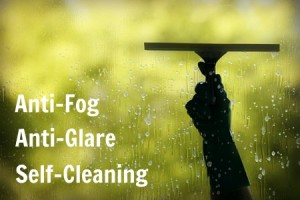
Have you ever wondered what it would be like if there was anti-fog, anti-glare and self-cleaning glass? Well, now we could ponder on that thanks to a new research by The MIT.
The secret twist of the research is layers of glass that are selectively removed to create microscopic cones. This nanotech innovation adds the desirable characteristics for this wonder glass. The glass would essentially look nearly invisible because of the lack of glare, fog or any other visual cue that the eye can see. Here is the paper that describes in detail this interesting technology.
Ultimately, if this technology can be implemented using an inexpensive manufacturing process, it could highly enhance the optical devices, the screens of smartphones and televisions, solar panels, car windshields and even windows in buildings.
Imagine how convenient it would be if our beloved touch screen devices were not only reflection free, but also resistant to sweat contamination!
Solar panels would also be quite grateful for this cutting edge technology. How? Well, if solar panels installed on roofs and on the ground could repel liquid and even be self cleaning, that could help the panels provide as much optimal power as possible for solar panels need to be cleaned periodically to work properly, thus, making them time and energy efficient.
Yet the majority of the population would applaud the last feature; self-washed car windows, no more dirt and grit on the exterior surface of the windows, no more glare and reflections that can impair visibility, and yes no more waiting for hours in those cold morning for the fog to evaporate!
Well, why haven’t we thought of this earlier? Maybe we should’ve paid more attention to nature, since that’s where the researchers seem to have drawn their inspiration from! Here is the statement from the MIT website:
“textured surfaces ranging from lotus leaves to desert-beetle carapaces and moth eyes have developed in ways that often fulfill multiple purposes at once. Although the arrays of pointed nanocones on the surface appear fragile when viewed microscopically, the researchers say their calculations show they should be resistant to a wide range of forces, ranging from impact by raindrops in a strong downpour or wind-driven pollen and grit to direct poking with a finger. “
Further testing will be needed to demonstrate how well the nanotextured surfaces hold up over time in practical applications, the report noted.
The research was funded by the Army Research Office through MIT’s Institute for Soldier Nanotechnology; the Air Force Office of Scientific Research; Singapore’s National Research Foundation through the Singapore-MIT Alliance for Research and Technology (SMART) Center, and the Xerox Foundation.
![]()

Looking for a simple, elegant backup solution?
Genie Timeline 2012 is a new version of the number one continuous data protection program Timeline 2.1. It offers the first metro style user interface; enhanced performance, and added features. Like us on Facebook and Follow us on Twitter for the latest news.
>Follow @Genie9backup
![]()

